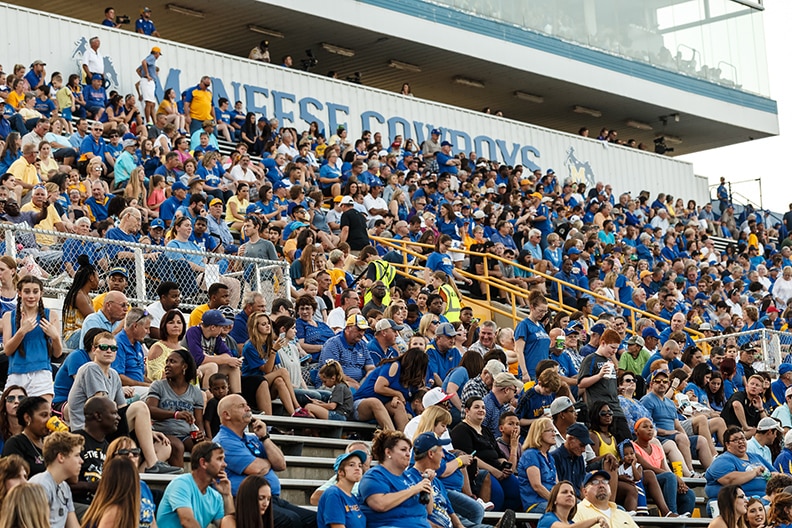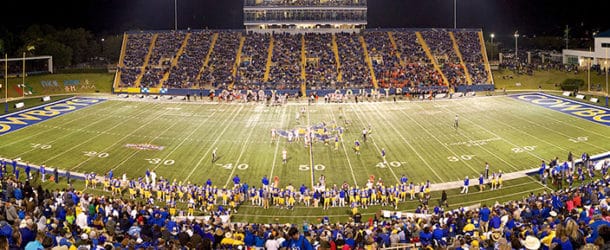THE MSU GATE GAME
BY RICK SARRO
It seems like they just kicked off the 2016 McNeese football season, and now it will come to a close in a few short days.
Ten games have gone by in a blur. Admittedly, my mind is a bit cluttered this late in the year, but this season has gone by the quickest in recent memory. Maybe after the emotional trauma that was Central Arkansas week on Oct. 15, I was trying to speed this one to a timely conclusion.
I’ve spent considerable time dissecting the Cowboys’ impressive wins, along with the tough, disappointing losses so far. (It’s still a challenge to explain the heartbreaking 31-24 last-second loss at Southeastern Louisiana.)
At some point, I started wondering how McNeese was winning or losing the all important “gate game” — the always difficult battle for the fan’s share of mind, heart and pocketbook.
In college sports, programs not in the Power Five conferences scratch and claw and pull any marketing lever at their disposal to put as many fans in the stands as possible over the course of a five- or six-game home schedule.
That’s especially true for McNeese and their brethren in the FCS. Maybe the only notable exception is North Dakota State, which has won a record five straight FCS national championships.
At this point in the attendance race, through five home games, it’s been a mixed bag for McNeese. There are negatives for sure, but also positives, in light of some specific factors.
The numbers, or the official paid home attendance figures, tell most of the story — but not all. Through the first five home games of 2016, McNeese totaled 54,254 fans. That’s a decrease of 2,403 compared to 2015, when the Cowboys only played five regular season home games (not including the sixth home game, which was the play-off match-up against Sam Houston State).
Last year, during McNeese’s remarkable undefeated conference championship campaign, an average of 11,331 fans turned out at Cowboy Stadium. The regular season home gate total was 56,657.
So far, through five home games, the average is 10,850. That’s a difference of 481 fans. That’s a small percentage drop per game, but it can affect the bottom line.
If you go back to 2014, when McNeese staged six home games, a total of 66,577 fans attended for a per-game average of 11,096.
To match 2014’s total home attendance, the Cowboys will need 12,323 fans for the season finale against Lamar. That’s very doable. But the Blue and Gold faithful in the stadium will need to number nearly 1,100 more than the total gate from the last home game, which had the added allure of Homecoming.
They may not reach it with the playoffs out of the picture and Lamar slumping as well.
That’s a boatload of numbers and averages for a guy whose brain is not geared toward that discipline. But it’s a part of the McNeese game day coverage that can’t be ignored. From the season opener with Tarleton State through the SLC opener against Stephen F. Austin to the hyped-up matchup with Nicholls State and then the fourth home game versus Central Arkansas, attendance figures dropped for every home game.
Some were small decreases, but they were decreases all the same.
The gate did jump nearly 2,000 for the Oct. 29 homecoming affair with undermanned Abilene Christian.
I would say an additional 10,000-plus Cowboy fans might be added to the mix if you factor in the UL-Lafayette game on Sept. 10. It was a road game at Cajun Field, but it felt like at least half a home date with the strong contingent that made the short drive east on I-10.
When I look at how ticket sales and home attendance are doing in the face of the competitive sports and entertainment landscape, I always weigh in with the LSU effect on McNeese.
Whom LSU is playing, and when and where, will always affect McNeese attendance. If you think otherwise, you’re naïve and living in a vacuum.
McNeese diehards are also LSU fans and vice versa. They do co-exist in our region rather nicely. But when pressed with a conflicting kick-off, those local Tiger fans are either in Baton Rouge or at home watching the flat screen, and not in Cowboy Stadium.
Donald Trump may have had a hard time getting his supporters to admit their allegiance to pollsters. But the Trump campaign was successful in getting his fans to the voting booths, where they didn’t hesitate to pull his lever.
That will be my first and last Trump/presidential election analogy. I promise. The point is, a lot of people wear the Blue and Gold and say they are McNeese fans. But there are not enough of them who buy the ticket and occupy a stadium seat.
Another headwind aimed squarely at McNeese’s turnstiles this year has been the high number of TV games. Every home game, minus the opener against Tarleton, appeared on either ESPN 3, CST or the American Sports Network. Two of the Cowboys’ road games (UL-L and Sam Houston State) were also broadcast on ESPN 3, and in the case of the Cowboys/Cajuns, KPLC-TV also aired the match-up from Lafayette.
Programs like McNeese love to be seen on regional or national TV to expose their brand name and get the positive effects on recruiting (as well as the growing number of transfers on the market). But don’t underestimate the power of TV and the drag it can impose on home attendance. There’s no exact science for putting a firm figure on it. But in many cases, if Cox Sports Television is at Cowboy Stadium, there are fewer fans on hand.
When comparing McNeese’s average home attendance to that of other Southland Conference teams, there’s really no comparison. Annually, McNeese will outdraw all other league programs per home game. Cowboy Stadium is the largest in the conference, with a seating capacity of 17,800. Lamar and Northwestern State are second and third, respectively, at 16,000 and 15,971 seats.
All Southland Conference teams struggled at the gate. But McNeese had nowhere near the low numbers seen at Abilene Christian, Houston Baptist, Incarnate Word and Nicholls State. It boggles my mind how these programs pay the bills.
SLC powerhouse Sam Houston, which advanced to two national title games in 2011 and 2012, and back-to-back appearances in the FCS semi-finals, rarely gets anywhere near sell-out crowds at Elliott T. Bowers Stadium, which fills at just under 13,000 seats.
Small market size or over-saturated large markets like Houston and San Antonio (Incarnate Word); FBS competition; TV games; losing; lousy product on the field; I could go on. It all affects small school home attendance.
McNeese has done a fairly good job of trying to market the football program. This year’s “Cowboy Up” television campaign built around first-year head coach Lance Guidry’s mantra was effective. The season ticket advertising push during the off-season is always needed. Game day advertising is a necessary expense.
But the frequency of these marketing tactics is limited because of the expense — especially during this time, when the athletic budget is cut to the bone.
More can be done and must be done if McNeese hopes to grow attendance averages and somehow stop the gate declines. McNeese and Learfield Sports, a national company contracted by the university to oversee sports marketing, advertising, corporate sponsorships and game day operations, have to do a better job of establishing a marketing platform and building their sports brand and identity.
Athletic director Bruce Hemphill has correctly warned since he took over the job that the chase for the entertainment dollar is tight and competitive. He laments that there is more to do now on Saturday nights, and more football options on the vast number of cable channels.
The bottom line is it’s damn hard to beat the high def, giant size flat screen at home, where the food and drinks are free; it’s never too hot or raining; and you can always pause the action when nature calls.
Season ticket price increases and process changes established a number of years ago through the formation of the McNeese Foundation by former athletic director Tommy McClelland were met with intense opposition by some long-time Cowboy fans. Many didn’t renew their ticket plans.
Costs go up. Change is slow and difficult, even when it’s needed for the long-term good.
Winning isn’t always the cure, either — not at this level of college football. Go back to 2014, when the Cowboys finished 6-5 and averaged 11,000 per home game. And that was the year they opened with a near upset of then-19th ranked Nebraska in Lincoln.
In 2015, then-coach Matt Viator guided the Cowboys to a perfect 10-0 season and their 14th SLC championship. But average home attendance only increased by 2 percent.
Then 2016 came, with the energy, passion and down-home Cajun appeal of new coach Lance Guidry.
But the home gate is down 2,400 fans through five games.
This is not, nor should it be, foremost in Guidry’s mind. But as head coach, he should be aware of the numbers and trends.
His job is to put the best possible team and product on the field to win as many games as possible.
It’s the guys without the whistles who must figure out how to win the gate game.
















Comments are closed.